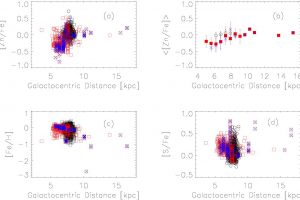The chemical evolution of our Galaxy studied with GES. The study: “The Gaia-ESO Survey: Galactic evolution of sulphur and zinc” of S. Duffau published on A&A

Stars more massive than 9 solar masses are efficient chemical labs, where hydrogen and helium are synthesized into other chemical elements, such as oxygen, carbon, and silicon. When these stars explode as supernovae (type I or “core-collpase” supernovae), these chemical elements are ejected into space, enriching the interstellar medium and being in future available to form new generations of stars. Briefly, this is the history of the chemical evolution of the Universe…
Other chemical elements, with abundances similar to iron, are more efficiently produced in type I supernovae (produced by stars in binary systems). It is important to note that the chemical enrichment of heavy elements by these two families of supernovae have different timescales, so that it is possible to trace the history of stellar formation and evolution in galaxies or in the Universe at different epochs by analyzing the abundances of different chemical elements.
However, such an investigation has always been hampered by the small number of stars whose spectra have been acquired at sufficiently high spectral resolution. This until the Gaia-ESO Survey have made available more than 100000 high resolution spectra of Milky Way stars. The study “The Gaia-ESO Survey: Galactic evolution of sulphur and zinc” of S. Duffau, astronomer of the Millennium Institute of Astrophysics (Santiago, Chile) is focused on the abundances of sulfur and zinc in 1301 stars observed in GES, with the aim of tracing their abundances across the Milky Way and derive important information of the evolution of our Galaxy. The astronomers Ettore Flaccomio and Francesco Damiani of the Astronomical Observatory of Palermo are coauthors of this study.
The Figure (link) shows the abundances of [Zn/Fe] (a), [Fe/H] (c), and [S/Fe] (d) for the sample of stars analysed as a function of their Galactocentric distance. Dwarf stars are represented as black open circles, giant stars as red squares, and stars in clusters as blue crosses. Panel b: average [Zn/Fe] in different distance bins for dwarfs (black circles), giants (red squares) and for stars in clusters (blue crosses).
